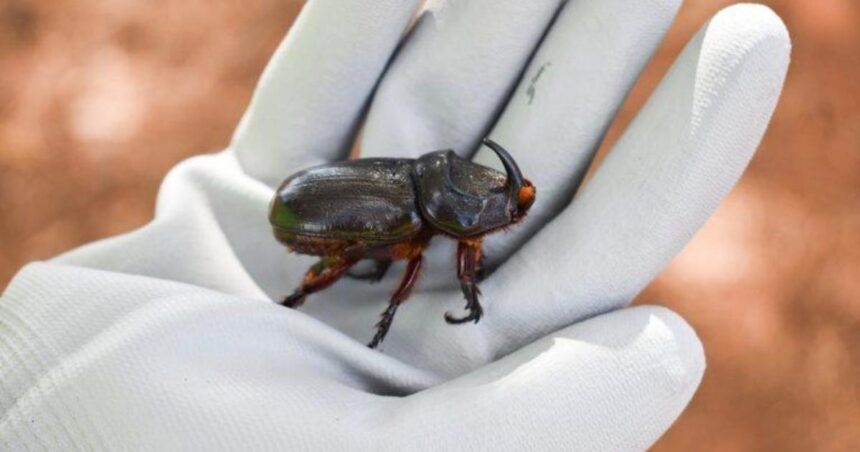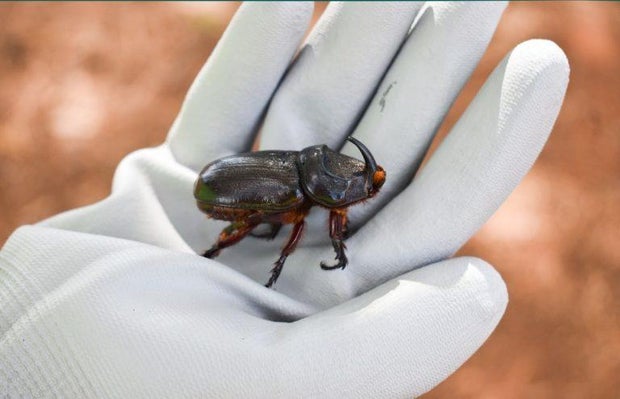Hawaii has ramped up efforts to stop the spread of coconut beetles, and invasive species which has increased its presence drastically since it was first detected in the country ten years ago.
According to the state’s Invasive Species Council, the beetles – native to Africa, China and Southeast Asia – are about two inches long with a C-shaped body. They are nocturnal and can fly up to two miles in search of food sources, and female beetles emit 50-140 eggs during their lifetime, usually four to nine months.
First discovered in Hawaii in 2013 at Joint Base Pearl Harbor-Hickam, the invasive species spread across the country last year and has been detected several times in recent months, officials said. Coconut rhinoceros beetles don’t bite but can carry diseases because they live in dirt and mulch, experts say.
According to Hawaii’s Invasive Species Council, the beetle can kill coconut trees, palms and other tropical plants like kalo and banana, once they are eliminated, which ultimately “destroys the economy, the entire ecosystem, agriculture and food security.”
Hawaii Department of Natural Resources
Earlier this month, Honolulu removed infected coconut trees from Kaiaka Bay Beach Park in an effort to control the invasive species, Hawaii News Now reported.
“It’s a sad day for us. We don’t like to take down trees, especially trees like coconuts. Not only the ‘Tree of Life’, culture is very important to Hawaiians, so today is also a sad day. and it will be a sadder day,” said Roxanne Adams, administrator of the City’s Parks Department and Forestry Recreation Division.
On the North Shore, about 80 trees are scheduled to be removed because of the beetles, the station reported.
“The unfortunate truth of this situation right now is it’s going to get worse before it gets better,” said Nate Serota of the Parks and Recreation Department. “We will have to start removing more and more of these Palms, really out of concern for public safety.”
More than 100 traps have been set up across the state and monitored regularly, and earlier this month, the state designated Oahu as having a beetle infestation. Under the new rules, landscaping materials such as compost, wood chips, mulch, and palms taller than four feet are not allowed to be shipped from Oahu.
Hawaii board strengthens pest control powers
The Hawaii Board of Agriculture has approved rule changes to help control the spread of invasive species after a 20-month delay.
The arrests sparked public outcry over the rule change to help the Department of Agriculture prevent the movement of commodities infested with pests, including the coconut rhinoceros beetle.
Once finalized, the rules will ban the movement of infected materials such as soil and compost between islands and increase inspection requirements. They will also include specific examples of invasive species to guide the department and industry.
Neither supporters nor opponents of the rule change seemed satisfied after Tuesday’s council meeting. Agricultural industry representatives are said to be confused, while some advocates say it doesn’t go far enough.
Council members, who approved the changes unanimously, agreed that invasive species need to be dealt with better, and quickly.
“It’s about an all-hands approach to managing, preventing — and hopefully breaking — the cycle of invasive species,” said Big Island council member Dianne Ley.
That sentiment echoes a message from a federal invasive species expert who visited Oahu this week to examine the effects of invasive species on island communities. They will produce a report to advise the US government on how to help Hawaii and its island territories, as well as the associated Micronesian countries.
Local advocates for action against invasive species told federal advisers Monday, pointing to gaps in Hawaii’s response and regulations to address the problem.
The agriculture board’s action on Tuesday was a significant step after a 20-month wait since board chairwoman Sharon Hurd withdrew proposed rule changes in the face of industry concerns.
Coconut rhinoceros beetles were first detected on the islands the following month, while tiny fire ants caused serious concern on Oahu’s windward coast.
Compost, soil and green waste, as well as the nursery trade, have been blamed for the movement of the pest.
The board has approved interim rules to limit the movement of host material for beetles and ants.
On Tuesday, Hurd voted to make the change permanent.
The newly approved rule has buoyed the hopes of environmental advocates, including Joseph Watt Project KEY, a Kualoa-Heeia community organization.
“I support the amendment; we need stronger regulatory oversight of the movement of these materials,” Watt said.
Hawaii Floriculture and Nursery Association President Eric Tanouye said Tuesday that his membership would be more open to rule changes as long as the agriculture department provides better guidance on how to comply. About 11 months ago, Tanouye said the revised rules would “kill agriculture.”
The rule change, while welcome, should be a benchmark for further work to increase the department’s regulatory powers, said Stephanie Easley of the Coordinating Group on Alien Pest Species, which is affiliated with the University of Hawaii.
Additional rule changes are needed to prohibit the sale of infected plant material, Easley said on the board Tuesday.
“Islands are a bellwether for the impact of invasive species”
Questions have been raised about how the department will implement the rules, given its history of struggling to find staff and funding. The signing of Act 231 this year set aside about $10 million for the department to improve its work on invasive species and biosecurity, after lawmakers pressed the DOA to do a better job.
Ten pest control positions were created with the funds, and Plant Quarantine Branch Manager Jonathan Ho said they are being filled.
On Tuesday, council members asked staff to provide monthly updates on progress in pest control, especially as the agency finalizes rules and implements programs under Act 231.
The rule changes will go before the Small Business Regulatory Review Board before reaching the governor’s office for final sign-off.
Federal government officials and invasive species experts are currently finalizing a report to be sent to the National Invasive Species Council, which oversees the expansion of pest management efforts nationwide and at several national agencies.
A three-day meeting in Honolulu of the federally appointed Invasive Species Advisory Committee, which includes two members from Hawaii, ended Wednesday.
On Monday, Hawaii officials and invasive species workers and academics shared their views on Hawaii’s invasive species problem.
“We need resources, we need people and we need capacity,” said Chelsea Arnott, Hawaii Invasive Species Council program supervisor.
Representatives from the US departments of Agriculture, Interior, Defense, Homeland Security and Health and Human Services were among the attendees.
The committee’s draft recommendations include seven key areas, such as expanding federal support for island-based invasive species efforts, increasing the need for island-specific research and infrastructure and addressing rapid shortfalls in species detection.
“Ultimately, these islands are a bellwether for the impact of invasive species, both nationally and globally, and indicate what continental communities and ecosystems will experience in the future,” the report said. “Thus, the science, systems, and solutions developed to deal with invasive species on islands can be applied across the United States.”





